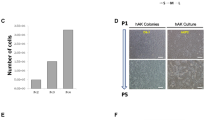Abstract
We searched for morphological evidence to support the hypothesis that stem cells are responsible for renal tubular cell proliferation. The rationale of the study was that if proliferation relies on progenitors, mitotically active cells should be less differentiated than their neighbors. As the retention of the thymidine analog BrdU has been the only approach employed to identify stem cells in the kidney up to now we additionally characterized BrdU-retaining cells. Rat kidneys were fixed by perfusion. Cycling cells identified by mitotic figures or the expression of the proliferating cell nuclear antigen (PCNA) were examined by light microscopy and electron microscopy as well as immunofluorescence for four differentiation markers. Newborn rats were injected with BrdU in order to detect label-retaining cells. After a period of 8, 14 and 35 weeks the kidneys were examined for BrdU by immunofluorescence and the four differentiation markers mentioned above. All cycling cells showed the same degree of differentiation compared to non-cycling cells. Most of the detected label-retaining cells were differentiated. We conclude that cycling cells in tubules of the healthy kidney are differentiated and that the retention of label is not a criterion to identify stem cells in renal tubules.








Similar content being viewed by others
References
Alison MR, Poulsom R, Forbes S, Wright NA (2002) An introduction to stem cells. J Pathol 197:419–423
Baumgart E (1997) Application of in situ hybridization, cytochemical and immunocytochemical techniques for the investigation of peroxisomes. A review including novel data. Robert Feulgen Prize Lecture 1997. Histochem Cell Biol 108:185–210
Bonventre JV (2003) Dedifferentiation and proliferation of surviving epithelial cells in acute renal failure. J Am Soc Nephrol 14:S55–S61
Brittan M, Wright NA (2004) Stem cell in gastrointestinal structure and neoplastic development. Gut 53:899–910
Dawson TP, Gandhi R, Le Hir M, Kaissling B (1989) Ecto.5′-nucleotidase: localization in rat kidney by light microscopic histochemical and immunohistochemical methods. J Histochem Cytochem 37:39–47
Fuchs E, Tumbar T, Guasch G (2004) Socializing with the neighbors: stem cells and their niche. Cell 116:769–778
Gupta S, Verfaillie C, Chmielewski D, Kim Y, Rosenberg ME (2002) A role for extrarenal cells in the regeneration following acute renal failure. Kidney Int 62:1285–1290
Ichimura T, Hung CC, Yang SA, Stevens JL, Bonventre JV (2004) Kidney injury molecule-1: a tissue and urinary biomarker for nephrotoxicant-induced renal injury. Am J Physiol Renal Physiol 286:F552–F563. Epub November 04, 2003
Imgrund M, Grone E, Grone HJ, Kretzler M, Holzman L, Schlondorff D, Rothenpieler UW (1999) Re-expression of the developmental gene Pax-2 during experimental acute tubular necrosis in mice 1. Kidney Int 56:1423–1431
Jensen UB, Lowell S, Watt FM (1999) The spatial relationship between stem cells and their progeny in the basal layer of human epidermis: a new view based on whole-mount labelling and lineage analysis. Development 126:2409–2418
Kale S, Karihaloo A, Clark PR, Kashgarian M, Krause DS, Cantley LG (2003) Bone marrow stem cells contribute to repair of the ischemically injured renal tubule. J Clin Invest 112:42–49. Epub June 16, 2003
Lehrer MS, Sun TT, Lavker RM (1998) Strategies of epithelial repair: modulation of stem cell and transit amplifying cell proliferation. J Cell Sci 111:2867–2875
Lin F, Igarashi P (2003) Searching for stem/progenitor cells in the adult mouse kidney. J Am Soc Nephrol 14:3290–3292
Maeshima A, Yamashita S, Nojima Y (2003) Identification of renal progenitor-like tubular cells that participate in the regeneration processes of the kidney. J Am Soc Nephrol 14:3138–3146
Megyesi J, Safirstein RL, Price PM (1998) Induction of p21WAF1/CIP1/SDI1 in kidney tubule cells affects the course of cisplatin-induced acute renal failure. J Clin Invest 101:777–782
Megyesi J, Andrade L, Vieira JM Jr, Safirstein RL, Price PM (2002) Coordination of the cell cycle is an important determinant of the syndrome of acute renal failure. Am J Physiol Renal Physiol 283:F810–F816
Mengel M, Jonigk D, Wilkens L, Radermacher J, von Wasielewski R, Lehmann U, Haller H, Mihatsch M, Kreipe H (2004) Chimerism of metanephric adenoma but not of carcinoma in kidney transplants. Am J Pathol 165:2079–2085
Morigi M, Imberti B, Zoja C, Corna D, Tomasoni S, Abbate M, Rottoli D, Angioletti S, Benigni A, Perico N, Alison M, Remuzzi G (2004) Mesenchymal stem cells are renotropic, helping to repair the kidney and improve function in acute renal failure. J Am Soc Nephrol 15:1794–1804
Oliver JA, Maarouf O, Cheema FH, Martens TP, Al-Awqati Q (2004) The renal papilla is a niche for adult kidney stem cells. J Clin Invest 114:795–804
Rookmaaker MB, Verhaar MC, van Zonneveld AJ, Rabelink TJ (2004) Progenitor cells in the kidney: biology and therapeutic perspectives. Kidney Int 66:518–522
Schrier RW, Wang W, Poole B, Mitra A (2004) Acute renal failure: definitions, diagnosis, pathogenesis, and therapy. J Clin Invest 114:5–14
Witzgall R, Brown D, Schwarz C, Bonventre JV (1994) Localization of proliferating cell nuclear antigen, vimentin, c-Fos, and clusterin in the postischemic kidney. Evidence for a heterogenous genetic response among nephron segments, and a large pool of mitotically active and dedifferentiated cells. J Clin Invest 93:2175–2188
Acknowledgments
We thank M. Enderlin and L. Kläusli for excellent technical assistance.
Author information
Authors and Affiliations
Corresponding author
Rights and permissions
About this article
Cite this article
Vogetseder, A., Karadeniz, A., Kaissling, B. et al. Tubular cell proliferation in the healthy rat kidney. Histochem Cell Biol 124, 97–104 (2005). https://doi.org/10.1007/s00418-005-0023-y
Accepted:
Published:
Issue Date:
DOI: https://doi.org/10.1007/s00418-005-0023-y




